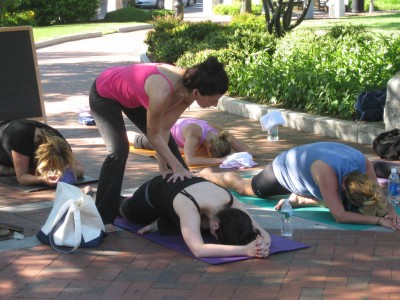Sometimes, after we’ve been teaching  a while, we look for different things we can do to bring some new life to our teaching. It’s not that the teaching is boring, per se, but it might mean we’re looking for ways to challenge ourselves and to ensure we’re learning and growing as much as possible. No one wants to feel like they’re in a rut and once we stop learning and challenging ourselves, we’re sure to fall into one.
I’ve been teaching for over ten years and for much of that time, taught a very similar sequence in a fairly similar way. I absolutely added variety in the form of different poses within the different sections of the practice but from an overall standpoint, I taught a very similar class from day to day. There are lots of reasons for this and many benefits. Also, on more than one occasion each week, I offer up a very standard sequence as a way to work with beginners or in classes where the student population or just the overall energy in the room would suggest a more standard flow would be a good fit.
But one of the things I’ve been playing with lately is the idea of theming classes around an anatomical theme. I’ve spent a lot of time studying anatomy and while I am still learning about all the various aspects, I’ve grown to absorb a great deal of information which I now use in my sequencing. I’ve started focusing on one aspect of movement or anatomy, for example, hips or external rotation of the hips and shoulders. I then build a sequence based on this. While this has certainly been done before, for someone who is used to teaching the same flow class after class, it is a challenge to have to think outside this standard sequence and trust that you can teach the details of the class, while at the same time keeping this overall theme in mind.
Another aspect of teaching that can help us to stretch is to look at how we speak. As yoga teachers, our voice is the primary way to communicate the postures and sequence to the class along with other thoughts and insights we chose to share. There are quite a few traps we can fall into: the first one is the trap of speaking too much. This can happen out of nervousness, habit or even discomfort with the idea of leaving students in silence. One thing to try is to say less rather than more, but speak only the essential things necessary to create the desired action. Another aspect of speaking that we can observe is what we say. Are we talking about ourselves too much? Are we sharing things in a general way to bring overall themes into the class? Are we preaching or giving advice? Do we simply stick to the instruction and never go beyond that? All of these examples are of course, tempered by the personality and style of the teacher. My sense over the years of teaching myself is you need to find a style of expression that is authentic to you but it is also helpful to be alert to any of these things and just re-check yourself every once in a while.
The last area that you can look at is assisting. I come from a teaching background that includes a lot of experience with assisting and it’s part of my Anatomy Training and one of my Mentorship Modules. But I notice that in most classes, there is very little assisting done. As a teacher, there may be many reasons why you choose not to assist in class; lack of experience or perhaps being in a large class where you take on the role of overseeing the whole class. But, especially if you have little experience assisting, once you get that experience and get in there, it can add a new dimension to your teaching that can challenge you as well as will really (potentially) add a new dimension to your classes.
Regardless of what you decide to do always know that the best ways to challenge yourself as a teacher is to stick with the basic things: being present, authentic and of service.
Namaste.


Trackbacks/Pingbacks